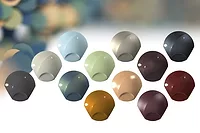Designers Present Future Automotive Color Trends
BASF's new trend collection is entitled RAW. The title aims to convey the designers' expectation to do more than create new automotive colors. The designers at BASF's Coatings division set out to design essential color concepts. The 2015-2016 BASF collection features approaches for the display of social trends and translates them into distinctive colors. "Continually challenging the consumeristic attitudes and searching for alternatives is also making itself felt on a global level in the world of colors of the RAW collection," said Astrid Van der Auwera, Global Strategic Marketing at BASF Coatings.
The RAW trend book addresses these complex changes and indicates how the call for more character/originality rather than more marketing can be implemented in automotive colors in the future. For instance, in the coming years, colors will employ unusual textures and surfaces to shape cars' character. This way, surfaces will get a more haptic appearance, either literally, by means of new concepts that use a perceptibly rough coating, or visually, owing to the specific composition of the pigmentation.
Blue Hues Characterize Technical Impression
Digital technologies are drastically changing our consumption and living habits. In the future, the Internet of Things will cause us to engage in dialog with our surroundings at all times. This interactivity is an important criterion for designing colors, which is manifesting itself in particular in the blue spectrum. "Colors with a technical character often have very complex effects that specifically interact with the light incidence," explained Mark Gutjahr, Head of Design at BASF's Coatings division in Europe. “Blue will play an important role in this field and will, despite the lower automobile registrations within the last few years, increase. This is also enabled by the extended portfolio in this color area.” The different hues reflect the versatile possibilities in a world in progress: the market will see anything, from bright blue shades to black blue color areas.
In addition to visual radiance, modern automotive colors can also feature strong colorful nuances. This shows that colors can be used as an activator for sensory perception: intense red, bright orange and brilliant yellow create an appeal which, connected with the materials used in the automobile, evokes distinctive associations.
Color with Many Effects
In the future, to expand the color spectrum and achieve unusual impressions, effects will be used deliberately on the European automotive market. XSpark® – a special-effect paint that has already received the Red Dot Award, one of the world's most important design prizes – gives the coating a particularly luxurious and elegant effect. Depending on how the light hits tiny glass particles in the paint, a distinctive sparkle is generated. For models in the luxury class segment in particular, this creates a homogeneous surface that supports shapes but is not pretentious.
New Materials for Various Products and Industries
For the first time, the trend book does not exclusively feature colors but also innovative materials for the future. In collaboration with the designers of BASF Coatings, designfabrik® chose five BASF materials that support technological change and help to create a new esthetic appeal – through pure performance, hidden beauty and surprising application options. Following the concept of the trend book “RAW”, these materials represent the original from which new possibilities beyond automotive engineering can be realized.
About BASF’s Coatings Division
BASF’s Coatings division develops, produces and markets innovative automotive coatings, automotive refinishes and industrial coatings as well as decorative paints. We operate sites in Europe, North America and South America as well as Asia Pacific. Within this network, we collaborate closely with our customers all over the world. In 2014, the Coatings division achieved global sales of about €3 billion. More information about the division is available at www.basf-coatings.com.
Looking for a reprint of this article?
From high-res PDFs to custom plaques, order your copy today!






